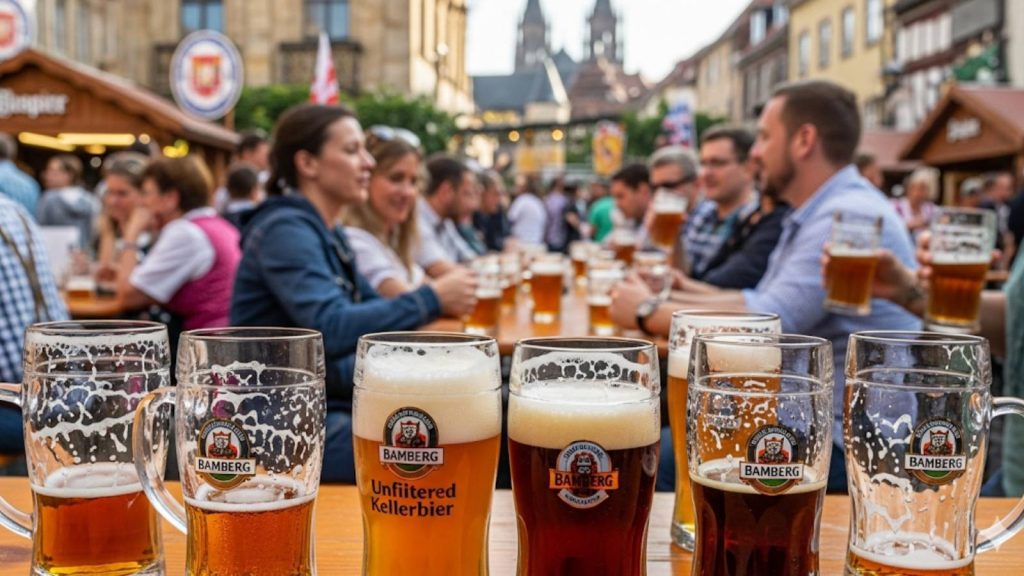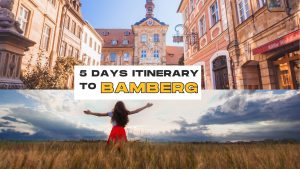Bamberg Beer Festivals in Germany capture the spirit of Bavarian brewing like nowhere else, offering travelers an authentic taste of Franconian tradition. Known as the “Beer Capital of Germany,” Bamberg blends medieval charm with a brewing legacy that stretches back to the 11th century. Walking through its cobblestone lanes and across its seven historic hills, the unmistakable aroma of malt drifting from centuries-old breweries.
Best Breweries in Bamberg: Guide to Historic & Modern Beer Spots
Below provided are some of the Beer Festivals, These festivals are more than events—they’re a celebration of community, craftsmanship, and the rich flavors that define German beer culture.
Why Bamberg Is Germany’s Beer Capital
The nickname “Beer Capital of Germany” is not marketing hype; it’s a statement of fact. Bamberg’s brewing history stretches back to at least the 11th century, when monasteries perfected recipes that remain influential today. Strolling along the cobblestoned lanes, you will notice the aroma of malt drifting from half-timbered breweries.
Bamberg 5 Days Itinerary: Historic Sites, Craft Beer & Secret Spots
The city’s seven hills, each crowned with a historic church, give it the nickname “Franconian Rome,” and every hill shelters taverns that pour their own house lagers and ales. Unlike larger beer cities such as Munich, Bamberg keeps its festivals intimate and community-focused, offering travelers a warm welcome and a glimpse into authentic Franconian life.
Top Annual Bamberg Beer Festivals to Add to Your Calendar
1. Sandkerwa – Old Town, Late August
Sandkerwa is Bamberg’s signature celebration and the highlight of the summer. Held annually during the last full week of August, the festival transforms the historic Old Town into a living fairground. Narrow alleys near the River Regnitz are decorated with colorful banners, while local brass bands play lively Franconian folk music well into the night.
Visitors can sample an impressive variety of beers—from classic Kellerbiers to limited-edition festival brews—served in traditional ceramic steins. Fireworks over the river on the closing night create a magical atmosphere, and cultural events such as the fishermen’s joust on the Regnitz add a unique local twist.
2. Annafest – Forchheim, Late July to Early August
Only a short train ride from Bamberg, the forested Kellerwald of Forchheim hosts Annafest, one of Franconia’s most beloved outdoor beer gatherings. Seventeen hillside cellars keep the beer naturally cool, and the tall oak trees provide shade even on the hottest days of summer.
Beyond beer, Annafest offers live music on multiple stages, traditional dance performances, and hearty Franconian food stands. Because many of the cellars serve their own unique brews—some available only during the festival—Annafest has become a pilgrimage for beer aficionados seeking rare flavors.
3. Franconian Beer Week – Bamberg Cathedral Square, Early May
Held during the first week of May, Franconian Beer Week brings together more than 40 breweries from across the region in Bamberg’s majestic Cathedral Square. Wooden stalls line the cobblestones, each offering a different style—from hoppy pilsners to dark, malty bocks—allowing visitors to sample a wide cross-section of Franconian brewing in one afternoon.
Local musicians and folk dancers create a festive yet family-friendly environment, and many breweries unveil new spring recipes specifically for the occasion.
4. Rauchbier Celebration – Schlenkerla Brewery, October
Bamberg is world-famous for its Rauchbier, a smoked beer with a distinct aroma reminiscent of a campfire. Each second weekend of October, the historic Schlenkerla Brewery on Dominikanerstraße hosts a celebration that draws enthusiasts from across Europe.
Master brewers explain the unique process of drying malt over beechwood fires, while visitors can join guided tastings and cellar tours. Seasonal dishes such as smoked pork shoulder and roasted chestnuts pair perfectly with the beer’s smoky depth.
Hidden Beer Events Only Locals Know
Beyond the headline festivals, Bamberg hides a network of smaller gatherings that reveal the city’s true character.
- Secret Keller Nights – Villages like Memmelsdorf, Merkendorf, and Strullendorf occasionally host evening beer sessions in hillside cellars known only to residents. These pop-up parties often feature live accordion music and homemade snacks, creating a rustic, intimate vibe. Travelers can learn about upcoming dates by chatting with bartenders or visiting local notice boards.
- Pop-Up Courtyard Tastings – Family-owned breweries such as Brauerei Greifenklau sometimes open their private courtyards for special limited-edition tastings. These events have no fixed schedule, rewarding curious explorers who ask around town for the latest word.
- Home-Brew Showcases – The Bamberg Homebrewers Club organizes quarterly meet-ups where experimental beers are poured and judged. From barrel-aged sours to inventive fruit ales, these gatherings demonstrate the creativity of the next generation of brewers.
Seasonal Brews You Can’t Miss
The rhythm of Bamberg Beer Festivals mirrors the changing seasons, offering different flavors throughout the year.
- Spring (March–May): Maibock Releases – Strong, malty lagers herald the arrival of warmer weather. Breweries such as Mahrs Bräu and Klosterbräu celebrate with tapping ceremonies where locals fill the beer garden to welcome spring.
- Summer (June–August): Kellerbier & Wheat Beers – Crisp, unfiltered lagers and refreshing wheat beers dominate outdoor beer gardens and riverfront spots. Many festivals coincide with riverside concerts, making summer evenings particularly memorable.
- Autumn (September–November): Märzen & Rauchbier – Rich, amber Märzen lagers pair perfectly with roasted meats and the golden foliage of the Franconian hills. This is also prime time for Rauchbier lovers.
- Winter (December–February): Holiday Ales & Eisbock – Dark, warming beers emerge at Christmas markets, including Bamberg’s famous Maxplatz Christkindlmarkt. Brewers often spice these ales with cinnamon or clove, creating a festive aroma that fills the chilly evening air.
Exploring Bamberg’s Historic Breweries
Bamberg’s nine city breweries form the backbone of its beer culture. Each has a unique story:
- Schlenkerla (Dominikanerstraße 6) – World-renowned for its smoky Rauchbier and centuries-old timbered interior where beer is still served directly from oak barrels.
- Klosterbräu (Obere Mühlbrücke 1) – Dating to 1533, it once brewed for Bamberg’s prince-bishops and still produces rich dark lagers.
- Mahrs Bräu (Wunderburg 10) – Famous for its unfiltered Kellerbier and lively beer garden, a favorite meeting place for locals.
- Fässla (Obere Königsstraße 19) – Known for malty Lagerbier and a bustling taproom that rarely quiets before midnight.
Many offer guided tours with behind-the-scenes access to centuries-old cellars. Booking ahead is recommended during festival periods.
Local Food Pairings Worth Savoring
Franconian cuisine is the perfect companion to Bamberg’s beers. Classic dishes include Schäuferla, a slow-roasted pork shoulder with crispy crackling, and Nürnberger sausages served with tangy sauerkraut.
Cheese lovers can enjoy Obatzda, a creamy Bavarian spread flavored with paprika and onions, which pairs beautifully with malty bocks. For a sweet finish, sample Bamberger Hörnla, a delicate local pastry ideal alongside a dark winter ale.
Travel Tips for Beer Lovers
- Best Time to Visit – Late spring through early autumn provides the richest festival lineup, but winter visitors can enjoy cozy brewery taverns and the magical Christmas market atmosphere.
- Getting Around – Bamberg’s compact Old Town is best explored on foot, while regional trains easily connect visitors to Forchheim, Aufseß, and other beer-trail towns. Bicycling is also popular, with well-marked paths linking surrounding villages.
- Where to Stay – Festival weeks fill up fast, so reserve accommodations early. Boutique hotels such as Hotel Nepomuk offer river views, while family-run guesthouses near the breweries provide warm Franconian hospitality at reasonable rates.
Day Trips and Nearby Beer Trails
Extend your journey with a trip along the Franconian Switzerland Beer Route, a picturesque loop through rolling hills and limestone cliffs. Tiny towns like Aufseß boast the world’s highest brewery density, allowing visitors to hike from village to village while sampling house-brewed specialties. Scenic castles and ancient monasteries along the route add historical charm to each stop.
Practical Guide: Tickets, Costs, and Etiquette
Most Bamberg Beer Festivals are free to enter. Visitors typically pay €3–€5 per half-liter and leave a small deposit for the festival mug or stein. Cash remains the preferred method of payment. When toasting, always look your companions in the eye and say “Prost!”—a sign of respect in Bavarian culture.
Take your time: Franconian beers often carry a higher alcohol content than they taste, and pacing yourself ensures you can enjoy the full range of flavors.
Raise your glass, say “Prost,” and let Bamberg’s unforgettable festivals guide you through a beer journey you’ll remember long after the last sip.
FAQs
1. What makes Bamberg Beer Festivals unique compared to other German beer events?
Bamberg Beer Festivals focus on intimate, community-driven celebrations rather than massive crowds. The city’s medieval setting, centuries-old breweries, and signature Rauchbier (smoked beer) create a distinctive atmosphere that highlights authentic Franconian traditions.
2. When is the best time to visit Bamberg for its beer festivals?
The prime festival season runs from early May through late October, starting with Franconian Beer Week in spring, peaking in summer with Sandkerwa and Annafest, and ending with the autumn Rauchbier Celebration. Winter also offers cozy brewery taverns and Christmas beer markets.
3. Do I need tickets to attend Bamberg Beer Festivals?
Most festivals are free to enter. Visitors usually pay per drink, around €3–€5 for a half-liter, plus a small refundable deposit for the festival mug or stein.
4. Which are the must-visit Bamberg Beer Festivals?
Top highlights include:
- Sandkerwa (late August) in Bamberg’s Old Town.
- Annafest (late July–early August) in nearby Forchheim.
- Franconian Beer Week (early May) at Bamberg Cathedral Square.
- Rauchbier Celebration (October) at Schlenkerla Brewery.
5. What types of beer can I try during these festivals?
Visitors can sample a variety of Franconian specialties such as unfiltered Kellerbier, malty Märzen lagers, refreshing wheat beers, strong Maibocks, and Bamberg’s iconic smoky Rauchbier.
6. Are the festivals family-friendly?
Yes. Many Bamberg Beer Festivals feature live music, folk dancing, traditional food stalls, and kid-friendly entertainment, making them enjoyable for families as well as beer enthusiasts.
7. How do I get to Bamberg and the surrounding festival locations?
Bamberg is easily reached by train from major German cities like Nuremberg and Munich. Regional trains and buses connect nearby festival spots such as Forchheim, Aufseß, and other Franconian beer-trail villages.
8. What local foods pair well with Bamberg beers?
Classic Franconian dishes include Schäuferla (roast pork shoulder), Nürnberger sausages, and Obatzda (cheese spread). For dessert, try Bamberger Hörnla, a buttery local pastry that complements malty beers.
9. Are brewery tours available during festival times?
Yes. Many historic breweries—such as Schlenkerla, Klosterbräu, Mahrs Bräu, and Fässla—offer guided tours and cellar visits. Advance booking is recommended, especially during peak festival weeks.
10. What cultural etiquette should visitors follow?
Always toast with eye contact and a cheerful “Prost!”, use cash for purchases, and pace yourself—Franconian beers can be stronger than they taste. Respecting local customs adds to the warm and welcoming atmosphere of Bamberg Beer Festivals.






